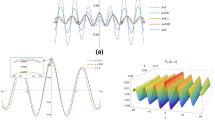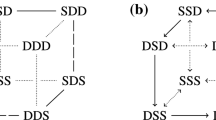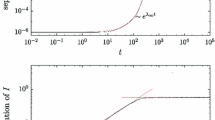Abstract
We consider a two-dimensional dynamical system that possesses a heteroclinic orbit connecting four saddle points. This system is not able to show self-sustained oscillations on its own. If endowed with white Gaussian noise it displays stochastic oscillations, the frequency and quality factor of which are controlled by the noise intensity. This stochastic oscillation of a nonlinear system with noise is conveniently characterized by the power spectrum of suitable observables. In this paper we explore different analytical and semianalytical ways to compute such power spectra. Besides a number of explicit expressions for the power spectrum, we find scaling relations for the frequency, spectral width, and quality factor of the stochastic heteroclinic oscillator in the limit of weak noise. In particular, the quality factor shows a slow logarithmic increase with decreasing noise of the form \(Q\sim [\ln (1/D)]^2\). Our results are compared to numerical simulations of the respective Langevin equations.









Similar content being viewed by others
References
Bakhtin, Y.: Noisy heteroclinic networks. Probab. Theory Relat. Fields 150(1–2), 1 (2011)
Burns, S., Xing, D., Shapley, R.: Is gamma-band activity in the local field potential of V1 cortex a “clock” or filtered noise? J. Neurosci. 31, 9658 (2011)
Elowitz, M.B., Leibler, S.: A synthetic oscillatory network of transcriptional regulators. Nature 403, 335 (2000)
Ermentrout, G.B., Beverlin, B., Troyer, T., Netoff, T.I.: The variance of phase-resetting curves. J. Comput. Neurosci. 31(2), 185–197 (2011)
Gardiner, C.W.: Handbook of Stochastic Methods. Springer, Berlin (1985)
Giner-Baldó, J.: Stochastic oscillations and their power spectrum. Master’s thesis, Freie Universität Berlin (2016)
Gleeson, J.P., O’Doherty, F.: Non-Lorentzian spectral lineshapes near a Hopf bifurcation. SIAM J. Appl. Math. 66(5), 1669–1688 (2006)
Hirsch, M.W., Smale, S., Devaney, R.L.: Differential Equations, Dynamical Systems, and an Introduction to Chaos. Academic Press, Amsterdam (2012)
Jülicher, F., Dierkes, K., Lindner, B., Prost, J., Martin, P.: Spontaneous movements and linear response of a noisy oscillator. Eur. Phys. J. E. 29(4), 449 (2009)
Jung, P.: Periodically driven stochastic systems. Phys. Rep. 234, 175 (1993)
Kummer, U., Krajnc, B., Pahle, J., Green, A.K., Dixon, C.J., Marhl, M.: Transition from stochastic to deterministic behavior in calcium oscillations. Biophys. J. 89, 1603 (2005)
Lindner, B., García-Ojalvo, J., Neiman, A., Schimansky-Geier, L.: Effects of noise in excitable systems. Phys. Rep. 392(6), 321–424 (2004)
Lindner, B., Schimansky-Geier, L.: Coherence and stochastic resonance in a two-state system. Phys. Rev. E. 61, 6103 (2000)
Lindner, B., Sokolov, I.M.: Giant diffusion of underdamped particles in a biased periodic potential. Phys. Rev. E 93, 042106 (2016)
Martin, P., Bozovic, D., Choe, Y., Hudspeth, A.J.: Spontaneous oscillation by hair bundles of the bullfrog’s sacculus. J. Neurosci. 23, 4533 (2003)
May, R.M., Leonard, W.J.: Nonlinear aspects of competition between three species. SIAM J. Appl. Math. 29(2), 243–253 (1975)
Meiss, J.D.: Differential Dynamical Systems. Society for Industrial and Applied Mathematics, Philadelphia (2007)
Rabinovich, M.I., Huerta, R., Varona, P., Afraimovich, V.S.: Transient cognitive dynamics, metastability, and decision making. PLoS Comput. Biol. 4(5), e1000072 (2008)
Rabinovich, M.I., Lecanda, P., Huerta, R., Abarbanel, H.D.I., Laurent, G.: Dynamical encoding by networks of competing neuron groups: winnerless competition. Phys. Rev. Lett. 87(6), 068102 (2001)
Rabinovich, M.I., Selverston, A.I., Abarbanel, H.D.I.: Dynamical principles in neuroscience. Rev. Mod. Phys. 78, 1213 (2006)
Risken, H.: The Fokker-Planck Equation. Springer, Berlin (1984)
Shaw, K.M., Park, Y.-M., Chiel, H.J., Thomas, P.J.: Phase resetting in an asymptotically phaseless system: on the phase response of limit cycles verging on a heteroclinic orbit. SIAM J. Appl. Dyn. Syst. 11(1), 350 (2012)
Stone, E., Holmes, P.: Random perturbations of heteroclinic attractors. SIAM J. Appl. Math. 50, 726 (1990)
Stratonovich, R.L.: Topics in the Theory of Random Noise. Gordon and Breach, New York (1967)
Thomas, P.J., Lindner, B.: Asymptotic phase of stochastic oscillators. Phys. Rev. Lett. 113, 254101 (2014)
Acknowledgements
JGB, PJT, and BL would like to acknowledge funding by La Caixa and DAAD (program 50015239), the National Science Foundation (Grant DMS-1413770), and BMBF (FKZ: 486 01GQ1001A) respectively.
Author information
Authors and Affiliations
Corresponding author
Appendices
Appendix A: Details on the Numerical Determination of the Spectrum from the Fokker–Planck Equation (Matrix-Inversion Method)
In Sect. 3 we derived two partial differential equations that determine the power spectrum. Here we show how these equations can be solved numerically by an eigenfunction expansion (for further details, see [6]).
1.1 Expansion into a Complete set of Functions
The power spectrum \(S_{z z}(\omega )\) is given in Eq. 9 in terms of an auxiliary function \(\tilde{H}(\varvec{\mathbf {y}};\omega )\), which is defined in Eq. 10 and satisfies the two-dimensional, second-order, partial differential equations,
where \(P_0(\varvec{\mathbf {y}})\) is the stationary probability distribution and \({{\mathrm{\mathcal {L}_{\text {FP}}}}}\) is the Fokker–Planck operator associated to \(\varvec{\mathbf {y}}(t)\). The solution to this system of partial differential equations may be found by expanding \(P_0(\varvec{\mathbf {y}})\) and \(\tilde{H}(\varvec{\mathbf {y}};\omega )\) into an appropriate basis of functions that satisfy the boundary conditions.
The heteroclinic oscillator system Eq. 1 with reflecting boundary conditions on the domain \(\Omega =[-\pi /2,\pi /2]\times [-\pi /2,\pi /2]\) can be shown to be equivalent (for certain observables \(f(\varvec{\mathbf {y}})\), such as \(z_i=\sin (y_i)\)) to a system with periodic boundary conditions on \(\Omega '=[-\pi ,\pi ]\times [-\pi ,\pi ]\) and the same dynamics. Thus, we expand the solutions into the basis of harmonic functions with period \(L_i=2\pi \) in both \(y_1\) and \(y_2\), i.e.
and, similarly,
Inserting Eq. 12 into Eq. 7, grouping the terms associated to each basis function \(e^{imy_1}e^{ily_2}\), and requiring that these terms should vanish for every combination m, l, we obtain for the coefficients of the steady state distribution
Additional symmetries present in the system impose further constraints on the set of coefficients \(\{c_{m,l}\}\): (i) because \({{\mathrm{\mathcal {L}_{\text {FP}}}}}(-\varvec{\mathbf {y}})={{\mathrm{\mathcal {L}_{\text {FP}}}}}(\varvec{\mathbf {y}})\) the density is symmetric under inversion, \(P_0(-\varvec{\mathbf {y}})=P_0(\varvec{\mathbf {y}})\), from which we find \(c_{-m,-l}=c_{m,l}\); (ii) \({{\mathrm{\mathcal {L}_{\text {FP}}}}}(\varvec{\mathbf {y}})\) is also invariant under the translations \((y_1, y_2)\mapsto (y_1+2\pi k, y_2)\) and \((y_1, y_2)\mapsto (y_1, y_2+2\pi k)\), from which we can infer that \(c_{m,l}=0\) if \(m+l=2k+1,k\in \mathbb {Z}\); (iii) because \(P_0(\varvec{\mathbf {y}})\) is real-valued, \(c_{-m,-l}=c_{m,l}^*\). Finally, from the normalization condition follows \(c_{0,0}=\pi ^{-2}\).
If we insert the expansions Eqs. 13 and 12 into Eq. 11 with \(f(y_1)=\sin (y_1)\) and follow the derivation for \(P_0(\varvec{\mathbf {y}})\) above, we obtain
This defines an infinite inhomogeneous system of linear equations. From the underlying symmetries of the problem follow further conditions on the coefficients (see Table 1).
Finally, to obtain the power spectrum \(S_{zz}(\omega )\) in terms of the coefficients, we plug Eq. 13 into Eq. 9 and use the orthogonality relations for the Fourier basis:
Choosing our observable to be \(z=f(y_1)=\sin (y_1)=(e^{iy_1}-e^{-iy_1})/(2i)\) and using \(\tilde{H}_{m, l}=-\tilde{H}_{-m,-l}\) leads to
where \(\mathfrak {I}[\cdot ]\) denotes the imaginary part of the argument.
1.2 Solving the Full Linear System
We start by solving the system Eq. A2 for the coefficients \(c_{m,l}\) of the expansion of \(P_0(\varvec{\mathbf {y}})\); this allows us to construct Eq. A2, which is then solved for the coefficients \(\tilde{H}_{m,l}(\omega )\) of the expansion of \(\tilde{H}(\varvec{\mathbf {y}};\omega )\) at each \(\omega \). From there, the power spectrum Eq. 14 is evaluated.
In the first place, we truncate the set of basis functions \(\{e^{imy_1}e^{ily_2}\}, -L\le m,l\le L\) and choose a specific ordering of its elements, according to which the coefficients \(c_{m,l}\) (resp. \(\tilde{H}_{m,l}(\omega )\)) are arranged into a column vector \(\varvec{\mathbf {c}}\) (resp. \(\varvec{\mathbf {h}}_{\omega }\)) which looks as follows
where \(^T\) denotes transposition and \(\varvec{\mathbf {c}}^{(L)}\) indicates that the size of \(\varvec{\mathbf {c}}\) depends on the truncation parameter L. Note that each entry of \(\varvec{\mathbf {c}}^{(L)}\) corresponds to a coefficient \(c_{m,l}\) associated to a basis function \(e^{imy_1}e^{ily_2}\), i.e.
One can define \(\varvec{\mathbf {h}}_{\omega }\) analogously. The chosen ordering is also used to set the elements of the matrices \(\varvec{\mathbf {M}}\) and \(\varvec{\mathbf {A}}_{\omega }\) of coefficients of the linear systems Eqs. A1 and A2, as well as the inhomogeneity \( \varvec{\mathbf {f}}\) on the RHS of Eq. A2.
With the previous ingredients we can write the equivalent of Eqs. 7 and 11 in matrix form as
where we have indicated the dependences of \(\varvec{\mathbf {M}}\) and \(\varvec{\mathbf {A}}_{\omega }\) on the noise intensity D, the stability parameter \(\alpha \) and the frequency at which we evaluate the power spectrum \(\omega \). After solving Eq. A3 once, we can determine \(\varvec{\mathbf {f}}\) and solve Eq. A4 for \(\varvec{\mathbf {h}}_{\omega }\) at a set of discrete frequencies \(\{\omega _i\},i\in {1,\dots ,N}\) to evaluate the power spectrum \(S(\omega )\) in a given frequency window.
The applicability of the numerical method outlined above is limited by the size of the matrices \(\varvec{\mathbf {M}}^{(L)}\) and \(\varvec{\mathbf {A}}_{\omega }^{(L)}\), which is determined by the truncation parameter L. In particular, the dimension of \(\varvec{\mathbf {M}}^{(L)}\) and \(\varvec{\mathbf {A}}_{\omega }^{(L)}\) grows as \((2L+1)^2\times (2L+1)^2 \), thus even small values of L yield large matrices. Solving linear systems described by large matrices is memory- and CPU-demanding. However, the use of efficient sparse matrix methods (\(\varvec{\mathbf {M}}^{(L)}\) and \(\varvec{\mathbf {A}}_{\omega }^{(L)}\) have very few non-zero entries) may alleviate these problems.
The issue of the high-dimensionality of the system becomes manifest prominently in the low-noise regime, which feature probability distributions displaying very abrupt changes on small spatial scales. In such cases, one must increase L in order to include modes \(e^{imy_1}e^{ily_2}\) with higher spatial frequencies \(|\varvec{\mathbf {k}}|=\sqrt{m^2+l^2}\) in the expansion of \(P_0(\varvec{\mathbf {y}})\) and \(\tilde{H}(\varvec{\mathbf {y}};\omega )\). This will limit in practice the applicability of the matrix-inversion method in the weak-noise regime, even if using sparse methods.
Appendix B: Estimating the Parameter \(\delta (\alpha )\)
Here we show how to calculate the value of \(\delta \) from a matching condition.
For our original system Eq. 1 in the absence of noise, i.e. for
the eigenvalues at the saddle points are \(\pm 1-2\alpha \), and the saddles are located at \((\pm \pi /2,\pm \pi /2)\). Consider the saddle located at \((\pi /2,\pi /2)\). The quadrant surrounding this point is the region bordered by the ingress boundary \((y_1=0,0<y_2\le \pi /2)\) and the egress boundary \((0<y_1\le \pi /2,y_2=0)\) (cf. Fig. 10). At this saddle, the stable eigenvector is (1, 0) and the unstable one is (0, 1). The difficulty in estimating the effective value of \(\delta \) is that the flow in this square is nonlinear.
Consider the deterministic linearization of the flow around the saddle at \((\pi /2,\pi /2)\) in terms of the variables \(u_1\) and \(u_2\):
We are interested in matching the properties (namely the first passage time distribution) of the linearized and nonlinear systems when the noise is very small. Thus, we aim to establish an explicit mapping between the deterministic flow of the linearized system and the deterministic flow of the nonlinear system, because for small noise the effect on the trajectories only comes into play close to the fixed point, where the linearization is accurate.
For the linearized system the ingress boundary is given by \(u_1=\delta ,0\le u_2<\delta \). In order to determine \(\delta \) we use the matching properties of the flows. In particular, we consider the flow along an invariant subset, namely the solution
which corresponds to the solution of the initial value problem starting from the ingress boundary
Thus we wish to solve the initial value problem
and choose \(\delta \) so that the linearized flow matches as the trajectories approach the saddle point. That is, we wish to choose \(\delta \) so that
Or, equivalently, we set
We can simplify this as follows: We use the relation \(y_1(t)=\text{ arcsin }(z_1(t))\) and the implicit solution for \(z_1(t)\), Eq. 49 in the asymptotic limit \(t\rightarrow \infty \). In this limit, \(z_1\) is very close to 1 and the time variable \(t(z_1)\) is dominated by the logarithm \(\ln (1-z_1)\). For a more precise approximation of Eq. 49 in the asymptotic limit, we can set \(z_1=1\) in the other two logarithmic terms
where \(t_s\) is the constant defined by the first two terms. This equation can be quickly solved for \(z_1\):
Making use of the series expansion
we find exactly the inverse of the diverging prefactor and the finite limit for \(\delta \):
which can be further simplified by Eq. B9, yielding Eq. 18.
Rights and permissions
About this article
Cite this article
Giner-Baldó, J., Thomas, P.J. & Lindner, B. Power Spectrum of a Noisy System Close to a Heteroclinic Orbit. J Stat Phys 168, 447–469 (2017). https://doi.org/10.1007/s10955-017-1809-8
Received:
Accepted:
Published:
Issue Date:
DOI: https://doi.org/10.1007/s10955-017-1809-8





